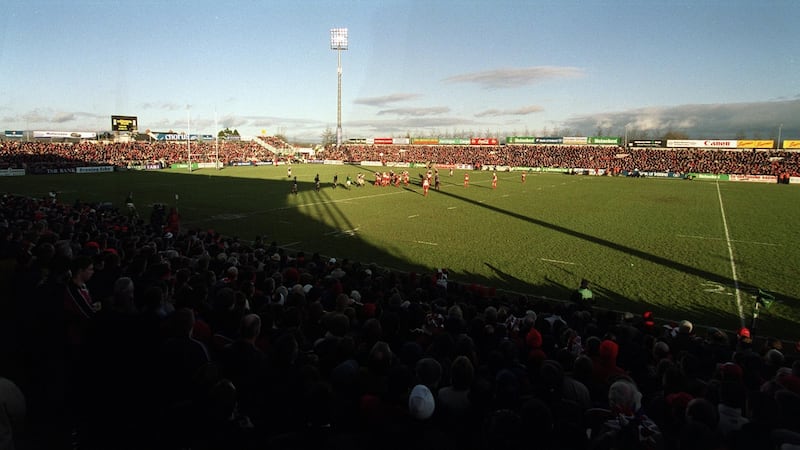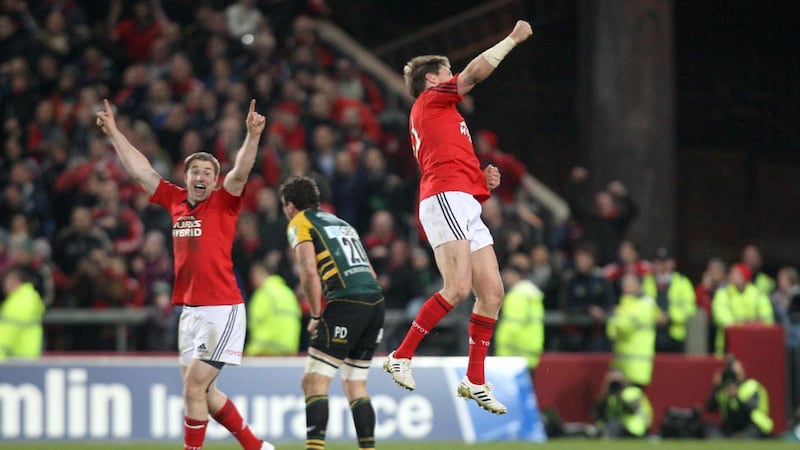Picture the scene. Around tea-time on a Saturday, it's approaching kick-off. Munster have their backs to the wall yet again, some Fancy Dans from England or France are in town and the mist is rolling in off the Clare hills. It was invariably cold, damp, gloomy and foreboding, particularly for the opposition.
At that point, back in the late 90s and for much of the noughties there was no better rugby ground in the world to be.
Empty, it was grey too; about as basic and unprepossessing a slab of grey as you could imagine. But all changed when it was packed with Munster fans, for Thomond Park has always been about its people.
Unlike anywhere else they were always in situ for the warm-up to roar their team into the dressingroom, before their songs penetrated the away dressingroom and then greeted the sides to thunderous ovations.
Aside from the silence studiously afforded kickers, on the rare occasions when Munster and Thomond Park was becalmed, all it would take was one piece of brilliance by a player in red, or a mistake by an opponent or, if all else failed, a good old scrap to turn up the volume and the temperature again.
Then, when Munster worked their way into the red zone, more often than not they’d be sucked over the try line. And it’s never, ever been over until the fat lady sings.

It’s always had the capacity to do strange things to players. While the men in red are inspired, the legs of opposing fullbacks and wingers often seemed to turn to jelly under high balls to the backdrop of that Thomond roar.
The ground first hosted a Munster Senior League tie between Young Munster and Bohemians in November 1934, and the original stand was opened in 1938. Until its refurbishment in 2007 it didn't seem as if much changed in the interim. It was due a face lift.
In truth too, its fabled history largely revolved around club games and specifically the Munster Senior Cup finals. That said, Munster’s citadel was founded on wins over all the major touring sides, and specifically of course the 12-0 win over the All Blacks in 1978. Graham Mourie’s side won all 17 of their other matches on that Grand Slam tour.
That win, the only one over an All Blacks side on Irish soil until 2018, became part of Munster and Thomond Park’s DNA as well as folklore. It gave credence to the Munster: ‘To the Brave and Faithful, Nothing is Impossible’. And so it has continually proved.
Yet when Munster played their first match in what was then simply the European Cup, it was on a Wednesday afternoon, November 1st, 1995 against Saracens, the estimated 6,000 attendance was one-third of the record crowd for an AIL derby between Shannon and Garryowen four seasons previously.
Back then, the Munster clubs and the AIL ruled. This European Cup thing was a curiosity, and Fortress Thomond would never even have taken off but for Pat Murray’s late match-winning try in a 17-13 victory.

The following season, just three days after being pummelled 48-18 in Cardiff, Munster were rank underdogs against an expensively assembled Wasps team drawn from five different nationalities and captained by Lawrence Dallaglio.
The Munster pack drove Anthony Foley over for the first try and Mick Galwey added the second as they went on to score seven tries in a mildly astonishing 49-22 win. Describing how he was hit by the wall of noise when running onto the pitch, Wasps' English scrumhalf Andy Gommarsall once vividly described how "the Munster forwards started to feed off the fans. You could see it happening. They grew in front of our eyes. After 20 minutes I remember thinking: 'Christ Almighty, this is different'."
After the game, manager Colm Tucker invoked the spirit of 1978. Fortress Thomond had its foundation stones.
Even so, a la Murray in 1995, in September 1997 Munster were indebted to a 76th-minute winning try by John Lacey to edge past Bourgoin 17-15. Despite this, defeats at home by Cardiff (in Musgrave Park) and in all three away left them bottom of their pool and rendered Munster's last game against Harlequins a dead rubber. The London club had already qualified and came looking to secure a home quarter-final.
Keith Wood would play one season with his native province in 1999-2000 but he played a major role in helping to create the mystique around Thomond Park that day – by captaining Harlequins.
In fact, he’d only played three games for Munster prior to joining Quins at the outset of professionalism in 1995, but his return ensured that for the first time Thomond Park was packed in feverish expectation. Wood’s presence in a Quins jersey was perhaps seen as an affront. It certainly galvanised home team and supporters alike. The presence of Will Carling may have helped too.

Munster were inspired, Foley was immense, as was Alan Quinlan in a man of the match performance, and tries by the Kiwi centre Rhys Ellison and Eddie Halvey, along with Killian Keane's unerring kicking and Munster's unflinching defence sealed a 23-16 win. The crowd celebrated as if Munster had beaten the All Blacks again as Frankie Flynn led the post-match rendition of There Is An Isle.
Creating an Irish citadel in those days was vital in another respect too. Back then, it was about all Irish rugby had. And fittingly it was in the garrison town.
Then, after Ulster lifted the European Cup in 1999 and before Brian O'Driscoll scored his hat-trick in Paris, Munster began winning away, notably in Vicarage Road against a start-studded Saracens.
But Thomond Park’s reputation for last-ditch Houdini-esque acts of escapology were taken to another level when they trailed Saracens by 30-24 entering injury time in their final pool game.

Whereupon that man Wood, now back with Munster, burrowed over and Ronan O’Gara kicked the match-winning conversion.
Recalling how David Humphreys had missed a last-minute penalty to beat France at home the previous season, O'Gara admitted afterwards: "That thought cropped into my head as I put the ball down. 'What have I got myself into here?' You're the hero or you're the villain. So far I've got two out of two, but one day I'm going to be on the other side of the fence. Today Limerick was on my side and the gods above were looking down on me. Jesus, there's a good story for you there now lads."
The Red Army was born abroad, circa 2000 and the semi-final in Toulouse, but the revolution in Irish rugby, for that is what it was, emanated from Thomond Park.
That the Miracle Match took place there is entirely apt, in January 2003 when Munster had to beat high-flying Gloucester by a minimum of 27 points and scoring four tries more – and duly did so when O’Gara converted John Kelly’s try with almost the last play of the game to win by 33-6. You couldn’t have scripted it.

The unbeaten run couldn't last forever, and came to an end after 25 wins when Leicester stormed the citadel in January 2007. Then the reigning champions for the first time, for once Munster had already qualified, all of which perhaps dulled their edge.
However, even in the midst of Thomond Park’s €40 million redevelopment in 2007-08, Munster won an almighty arm wrestle with Wasps en route to regaining their European crown. This was despite the side of the ground, which is now the East Stand, being closed.
The opening of the modern-day Thomond Park for a riday night game against little Montauban, making their tournament debut and fielding a second-string team, was only rescued by O'Gara's match-winning penalty.
The formal opening was the following month, when the All Blacks arrived, and how Munster – team and fans – invoked the heroes of 1978, who handed out the caps individually to the players beforehand.
Munster were missing 10 Irish internationals and although the All Blacks played a midweek starting team, a rout was envisaged. The tone was set by Munster's quartet of Kiwis, Doug Howlett, Lifeimi Mafi, Rua Tipoki and Jeremy Manning, performing their haka.
On an unforgettable and raucous night, Munster threw themselves fearlessly into contact on both sides of the ball. One New Zealand writer was so taken aback by the silence afforded the place-kickers that he wrote of hearing a dog barking outside the ground as Stephen Donald addressed the ball. Of course, as was often the case, it also served to completely unnerve Donald.
Ultimately Graham Henry had to bring on the heavy artillery – Kieran Read, John Afoa, Brad Thorn and Mils Muliaina – before Joe Rokocoko beat Howlett on his inside shoulder after Mafi had shot out of the line for a 77th-minute try to secure an 18-16 victory.

Another winning run in Europe, of 17 games, came to an end when a classy Ulster side inflicted a damaging defeat in the quarter-finals in 2012. There have been two more since, the December losses to Clermont and Leicester in 2014 and 2015 which contributed to rare pool exits.
Still, Munster's record at Thomond Park in the Heineken Cup reads: Played 71, Won 66, Drawn 1, Lost 4. That's not too shabby.
They've inflicted some spankings since, not least in twice putting 40-plus on Toulouse in a couple of quarter-finals. Their capacity for producing late drama there has also remained undimmed, witness O'Gara's drop goal into the Ballynanty end after 41 phases in the 84th minute to beat Northampton in October 2011 and Andrew Conway's slaloming solo try and Ian Keatley's conversion to beat Toulon in the quarter-finals in 2018.
Along the way, never have the crowd been more emotionally involved in a rugby match than in October 2016, when Munster hosted Glasgow the day after Foley's hauntingly moving funeral in Killaloe.
Yet despite such a draining week and seeing Keith Earls sent off in the 18th minute, Munster won 38-17. When the entire Munster squad took their traditional post-match celebratory version of Stand Up And Fight onto the pitch, and brought Foley's boys Tony and Dan into their circle, there wasn't a dry eye in the place.
It had perhaps taken Foley’s death to remind all concerned what a special ground this is. It really did feel like there was a 16th man that day. Then again, that’s often the way in Thomond Park.





















